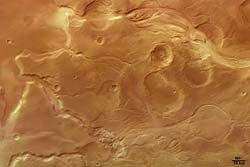This area deals with the fundamental laws and building blocks of nature and how they interact, the properties and the behavior of matter, and research into space and time and their structures.
innovations-report provides in-depth reports and articles on subjects such as astrophysics, laser technologies, nuclear, quantum, particle and solid-state physics, nanotechnologies, planetary research and findings (Mars, Venus) and developments related to the Hubble Telescope.

Experimental verification would mean more spatial dimensions exist
According to string theory, all the different particles that constitute physical reality are made of the same thing–tiny looped strings whose different vibrations give rise to the different fundamental particles that make up everything we know. Whether this theory correctly portrays fundamental reality is one of the biggest questions facing physicists.
In the June on-line Journal of High Energy Physics (JHEP)

These images of fluvial surface features at Mangala Valles on Mars were obtained by the High Resolution Stereo Camera (HRSC) on board the ESA Mars Express spacecraft.
The HRSC has imaged structures several times which are related to fluvial events in the past on Mars.
The region seen here is situated on the south-western Tharsis bulge and shows the mouth of the Mangala Valles and Minio Vallis outflow channels.
The source of the outflow channel is related to the Ma

Some slow, cold visitors stopped by Los Alamos National Laboratory last week, and their arrival could prove a godsend to physicists seeking a better theory of everything.
Researchers working at the University of California’s Los Alamos Neutron Science Center and eight other member institutions of an international collaboration took a giant step toward their goal of constructing the most intense source of ultra-cold neutrons in the world, measuring ultra-cold neutron production in

A Purdue University mathematician claims to have proven the Riemann hypothesis, often dubbed the greatest unsolved problem in mathematics.
Louis De Branges de Bourcia, or de Branges (de BRONZH) as he prefers to be called, has posted a 23-page paper detailing his attempt at a proof on his university Web page. While mathematicians ordinarily announce their work at formal conferences or in scientific journals, the spirited competition to prove the hypothesis – which carries a $1 million

Astrophysicists led by the University of Chicago’s Andrey Kravtsov have resolved an embarrassing contradiction between a favored theory of how galaxies form and what astronomers see in their telescopes.
Astrophysicists base their understanding of how galaxies form on an extension of the big bang theory called the cold dark matter theory. In this latter theory, small galaxies collide and merge, inducing bursts of star formation that create the different types of massive and bright galax

Folgende Wissenschaftlerin und Wissenschaftler stehen der Presse honorarfrei für Interviews zur Verfügung.
Prof. Dr. Gerhard Neukum
Institut für Geologische Wissenschaften, Fachrichtung Geoinformatik/Planetologie
Malteserstr. 74-100, 12249 Berlin
Telefon: 030/838-70570, -70575, Sekretariat
Schwerpunkte:
– Planetologie: Fernerkundung der Erde und der Planeten
– Astronomie
– Mars-Kamera
Tilmann Denk
Institut für Geologische Wissenschaften, Fachrichtung